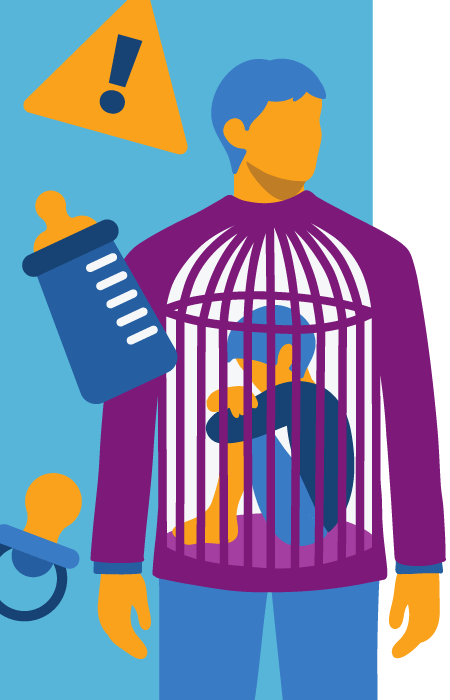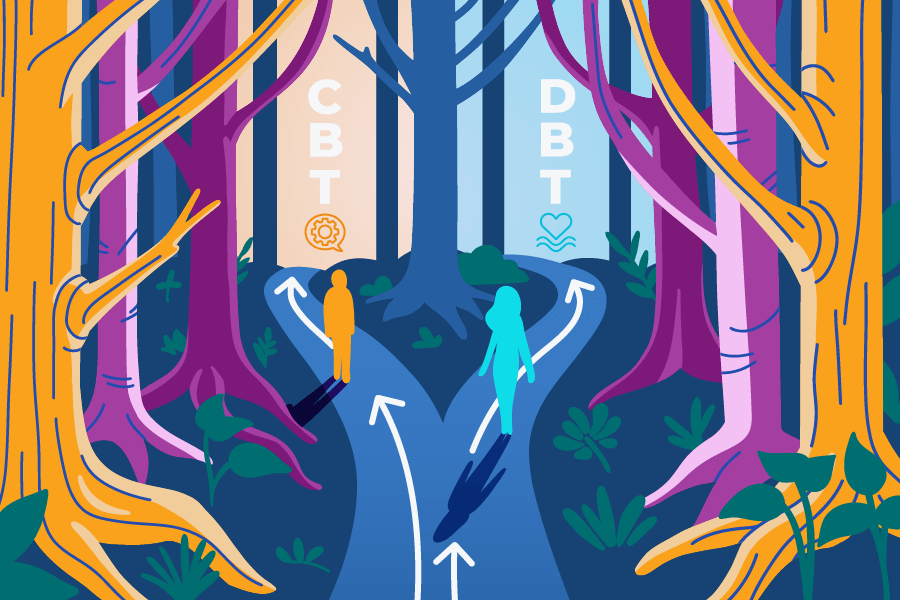What Is EMDR Therapy?
What Does EMDR Stand For?
EMDR stands for Eye Movement Desensitization and Reprocessing Therapy.
What Is EMDR Therapy and How Does It Work?
EMDR is a psychotherapy treatment designed to relieve and alleviate the distress caused by traumatic memories.
The process works by manipulating an adaptive information processing model (side-to-side eye movements) to ‘reprocess’ disturbing memories, helping you heal and move past them.
What Happens to Your Brain During EMDR?
During EMDR, bilateral stimulation is used to engage both sides of the brain, targeting how traumatic memories are stored.
EMDR therapy works by helping the two sides of the brain communicate with each other. This includes the left side of the brain and the right side.
By targeting how traumatic memories are stored, it forces the brain to process the memory properly.
Eventually, this allows one to remember traumatic events without being forced to experience the full intense and emotional reaction as though it were a fresh memory.
EMDR may also impact the brain in other ways, such as:
- Side-to-side eye movements help the brain to consolidate memories like it would naturally during REM sleep.
- Stimulating the brain region called the thalamus may cause cognitive processes that allow more refined control over emotional distress.
Does EMDR Work?
EMDR has been shown to have an immediate positive effect on clients in reducing their distress due to trauma-related disorders.
Is EMDR Evidence Based?
Yes, EMDR has been involved in numerous studies to test its effectiveness with repeatable results.
Though EMDR is not as researched as more commonly known therapies, results are promising, with many mental health care professionals endorsing its use to qualified clients.
It is recognized as an evidence-based treatment for post-traumatic stress disorder (PTSD), phobias, and other trauma-based disorders in treatment guidelines published by the World Health Organization (WHO) and other mental health care organizations, such as the American Psychological Association.
It is used in organizations that focus on treating people with PTSD as well, like the Department of Veterans Affairs.
Does EMDR Bring back Repressed Memories?
Yes, EMDR can bring up repressed memories during the recall process.
The goal of EMDR is to allow clients to access and process traumatic memories that are currently causing them distress.
However, the process can bring up memories connected to the currently processed memories. This includes memories that may have been blocked or repressed as part of the mind’s self-defense mechanism.
What Are the Pros and Cons of EMDR?
The pros of EMDR therapy include:
- Rapidly resolves trauma
It can increase the speed of healing for trauma survivors. - Fast relief
It works on immediate symptoms quickly, especially compared to traditional psychotherapies. - Clients do not have to talk about their disturbing memories
This helps those who are early in their therapy journey or are uncomfortable in therapy spaces. - Creates neurobiological changes that contribute to emotional healing and overcoming negative thoughts
- Effective treatment for negative beliefs associated with trauma, not just distressing memories
This helps the treatment last much longer than just burying traumatic experiences. - Reduces unhealthy coping skills, such as avoidance behaviors
- Works alongside other trauma-focused psychotherapies (also known as ‘talk therapy’), such as cognitive behavioral therapy (CBT)
Since both traditional psychotherapies and EMDR focus on the thought processes around trauma, they can go hand in hand.
The cons of EMDR therapy includes:
- EMDR can be an emotionally intensive process
Each EMDR therapy session requires clients to remember and engage with traumatic memories, which can be triggering and distressing. - Varied results
Though highly effective, EMDR therapy will affect each person differently and may not be as equally effective compared to other individuals.
- Less studied than traditional psychotherapies
Though promising, EMDR is not as studied as other evidence-based therapies, making it difficult to determine its effectiveness compared to other therapies. - Difficult to Access
EMDR sessions must be conducted by a specialized clinician trained by an EMDR international association-approved trainer. Not all clinical practices have therapists qualified to provide EMDR, which could limit clients’ options for treatment.
What Are the Eight Phases of EMDR?
There are eight phases of EMDR therapy, which are treatment planning, preparation, assessment, desensitization, installation, body scan, closure, and re-evaluation.
Phase 1: History and treatment planning: This is the initial stage of EMDR therapy, which consists of an EMDR therapist examining the client’s history and creating a treatment plan.
Phase 2: Preparation: The client and clinician establish trust. The client learns self-care and relaxation techniques that can be used during times of emotional distress or disturbances—both during and after a session.
Phase 3: Assessment: Clients access targeted memories in a controlled and standardized way to examine how they are effectively processed.
This phase utilizes the Subjective Units of Disturbance and Validity of Cognition (VOG) scale in assessing clients.
Clients select a specific memory or image from a targeted traumatic event, along with any associated negative self-beliefs or physical sensations.
They are then asked to rate their feelings on the subjective units of disturbance scale. Clients then choose a positive self-belief statement opposite to their negative belief and rate it on the VOC scale.
Phase 4: Desensitization: Clients work with the clinician to reduce the intensity of negative thoughts, distressing memories, and negative body sensations related to a traumatic experience.
Clients are instructed to focus on these negative memories and feelings as they are guided through the EMDR process by using sets of bilateral stimulation.
These can come in the form of rapid eye movements, tones, or taps.
After each set, clients are instructed to let their minds go blank and notice which feelings, images, thoughts, sensations, or memories come to mind. Sometimes, clinicians will move into other focuses of attention to help the client stay on track.
When the client reports a 0 on the subjective units of disturbance scale related to the targeted memory, the client moves to the next stage.
Phase 5: Installation: Clients concentrate on the strength of the positive belief they chose to replace their original negative belief. The goal is to measure this positive belief as a 7 (completely true) on the VOC scale.
Phase 6: Body scan: After the positive belief has been installed, the clinician will ask the client to bring the targeted traumatic event to mind to identify any residual negative physical sensations in the body. If so, these sensations are targeted to reprocessing.
Phase 7: Closure is the last part of an EMDR treatment session. Clients must leave the session feeling better than they did at the beginning.
Clinicians may perform calming techniques to assist in relaxation.
Clients are then briefed on what to expect between sessions and encouraged to utilize journals to record any thoughts and feelings that may arise as a tool for reflection.
Phase 8: Reevaluation: The clinician evaluates any issues a client continues to have and makes amendments to the treatment plan. This occurs before the next EMDR session.
What Are Some Exercises for EMDR?
You can practice EMDR techniques outside of a session by utilizing exercises such as:
- Butterfly Hug Method
- Visual Grounding
- Coherent Breathing
- Breathing exercises such as box breathing
How Long Does It Take for EMDR Therapy to Work?
Clients can usually experience immediate relief from as little as one to three sessions, though clients typically utilize about 12 or more sessions for maximum healing.
Dangers of EMDR Therapy
What Are the Risks of EMDR Therapy?
EMDR has no serious risks, but it may cause a temporary increase in distress.
Unresolved memories may also emerge with unanticipated reactions during high levels of emotion during treatment.
Why Is EMDR So Controversial?
Many uninformed people may view EMDR as a pseudoscience despite clinical evidence stating otherwise.
Who Is Not a Candidate for EMDR?
EMDR is not a susceptible treatment for clients who:
- Cannot tolerate certain levels of anxiety or stress
- Have recently experienced a traumatic event
- Cannot process emotions
- Experiencing hallucinations or delusions
Why Do I Feel Weird After EMDR?
Clients may feel mentally exhausted and emotionally drained after an EMDR session.
Though clients should not feel pain, they may feel the after-effects of stress or fear when recalling particularly challenging memories or disturbing events.
Why Does EMDR Fail?
The effectiveness of EMDR is only possible if you are willing to trust and work with a trained EMDR therapist.
EMDR may fail if the right memories are not targeted or when the wrong bilateral stimulation is used. Having unrealistic expectations or not being properly triggered or prepared for an EMDR session may also cause failure.
Can EMDR Cause Anger, Make Anxiety Worse, or Trigger Psychosis?
EMDR may cause feelings of initial distress, but it does not trigger psychosis, increase anger, or make anxiety worse.
Benefits of EMDR therapy
Who Is a Good Candidate for EMDR Therapy?
A good candidate for EMDR therapy are people who need fast relief from disturbing memories associated with conditions such as:
- Anxiety disorders
- Trauma-related disorders (including PTSD)
- Grief
- Eating Disorders
- Phobias
- Pain disorders
- Personality disorders
- Depression
How Quickly Does EMDR Work?
EMDR can start working in as little as one to two sessions. With EMDR, a single trauma can be processed within 3 sessions in 80-90% of the participants.
Can EMDR Heal Childhood Trauma?
EMDR can help clients process and heal from disturbing memories associated with childhood trauma and other adverse life experiences.
How Do You Know When EMDR Has Worked?
EMDR is successful when a client can recall a targeted memory without suffering from negative physical sensations, negative self-beliefs, or distress.









